Abstract
AIMS OF THE STUDY: Type-2 diabetic patients have excessive cardiovascular mortality, primarily related to diabetic nephropathy. The extent of the morbidity due to nephropathy in type-2 diabetes mellitus has not been fully quantified in Nigeria. This study aims to quantify the prevalence of micro- and macrovascular complications in hospitalized type-2 diabetic patients with nephropathy. METHODS: Over a three-year period, 465 type-2 diabetic patients were examined for nephropathy and diabetic associated diseases while on hospital admission. RESULTS: One-hundred-ninety-one patients (41.1%) had signs of different stages of diabetic nephropathy. There is a predominance of the male sex in the nephropathic groups. Disease duration is lowest in the non-nephropathic group (6.5+/-7.1 years) but varies between 9.4+/-4.1 years and 11.7+/-3.5 years in the nephropathic groups. Hypertension, left ventricular hypertrophy, stroke, and myocardial infarction were less common in the non-nephropathic group, p<0.05, but showed an upward trend with progression of nephropathy. Although foot amputation was uncommon, the total percentage of patients with diabetic foot increased with progression of nephropathy (17% in non-nephropathic group versus 67% in patients with chronic renal insufficiency). The overall prevalence of diabetic retinopathy increased with progression of nephropathy, especially the occurrence of proliferative retinopathy. CONCLUSIONS: A high morbidity was already present even in patients without nephropathy that increased in the course of the development of nephropathy. The study identifies patients with diabetic nephropathy as a high-risk group for excess cardiovascular morbidity in Nigeria. Thus, it is imperative to aggressively prevent or slow down progression of diabetic nephropathy.
Full text
PDF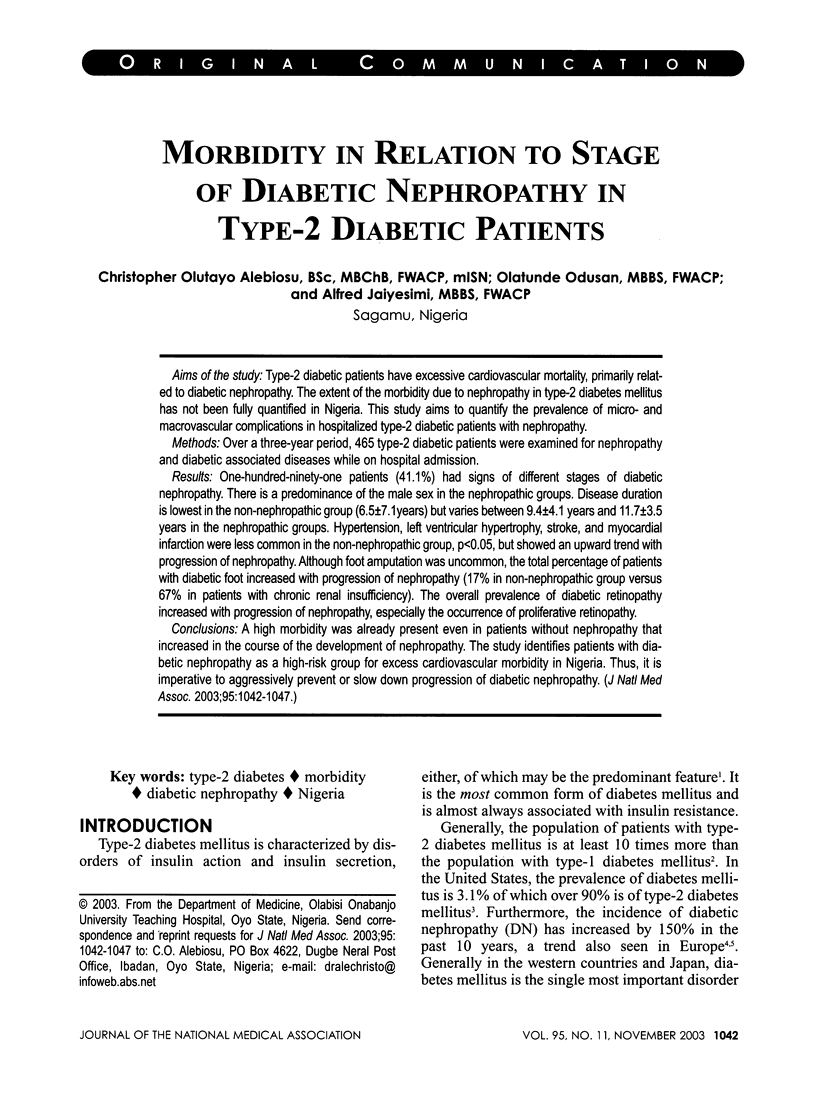
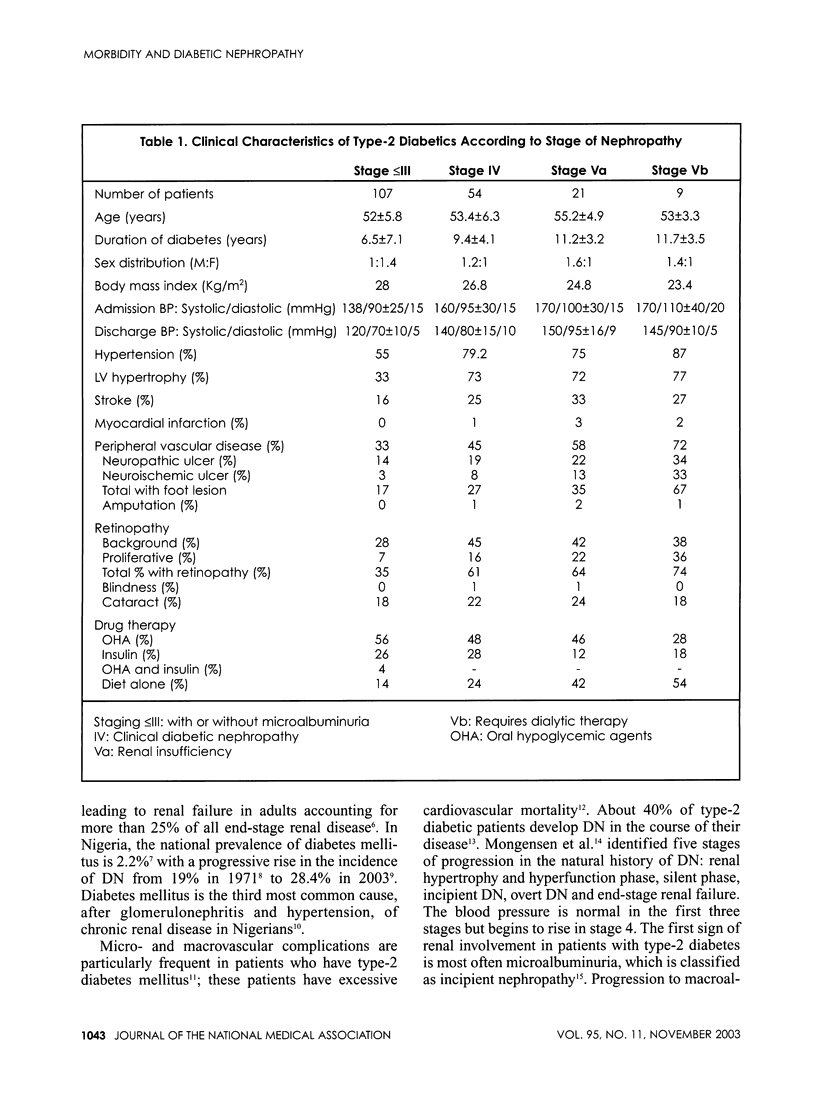
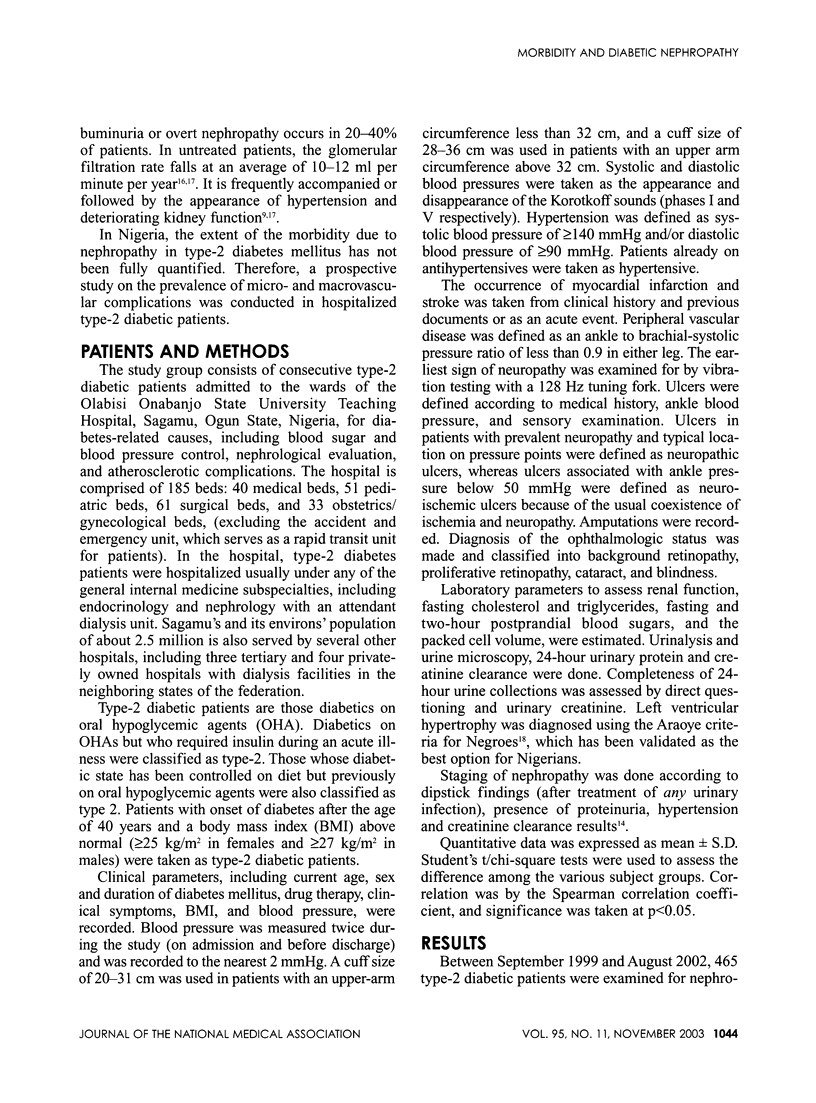
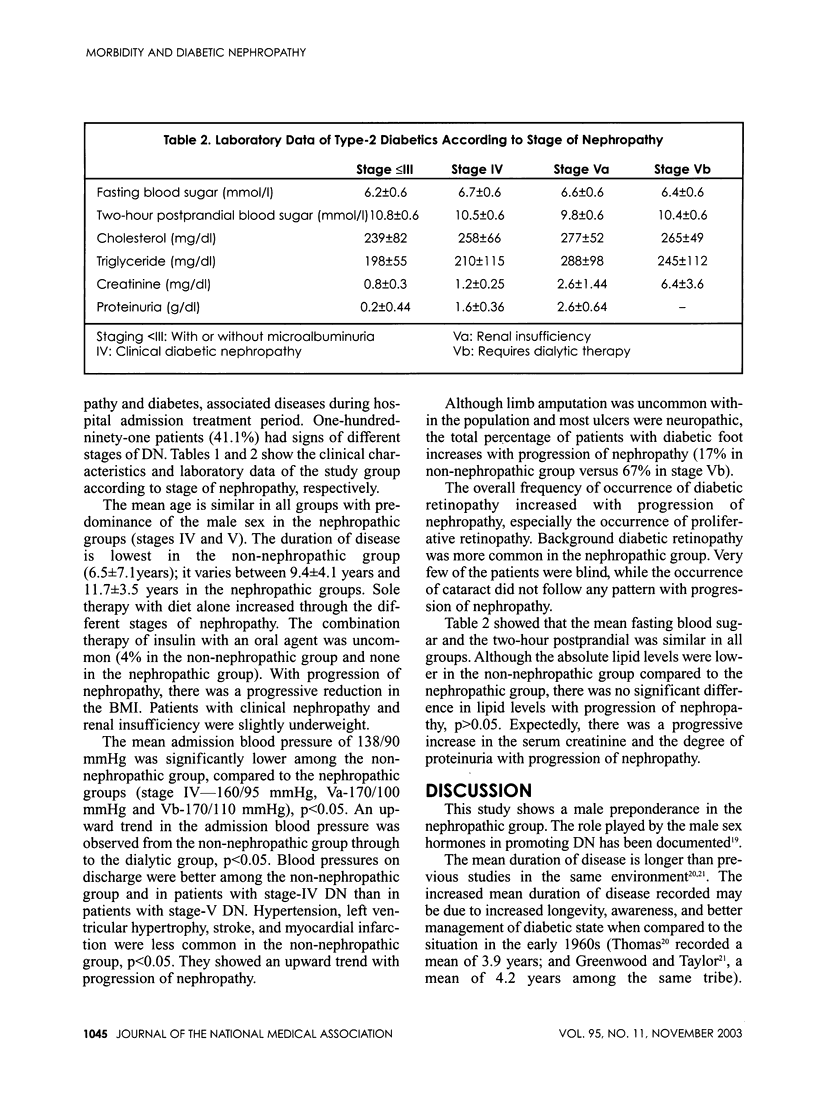
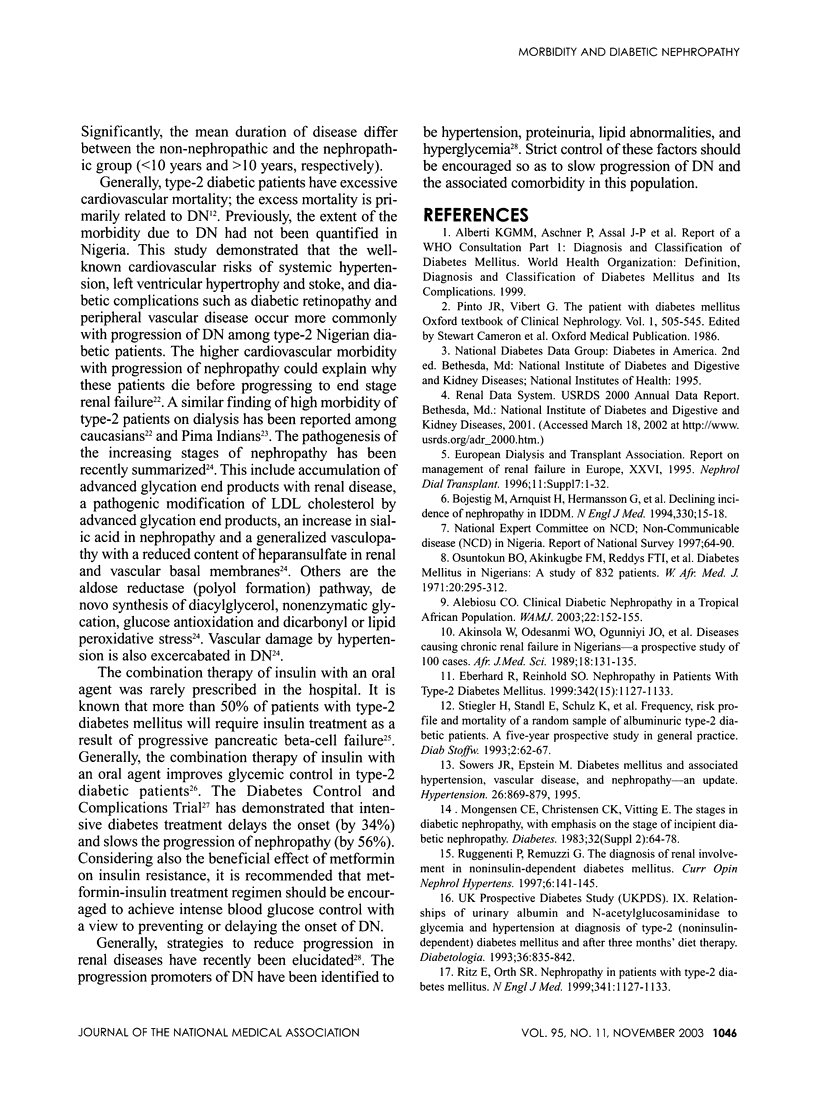
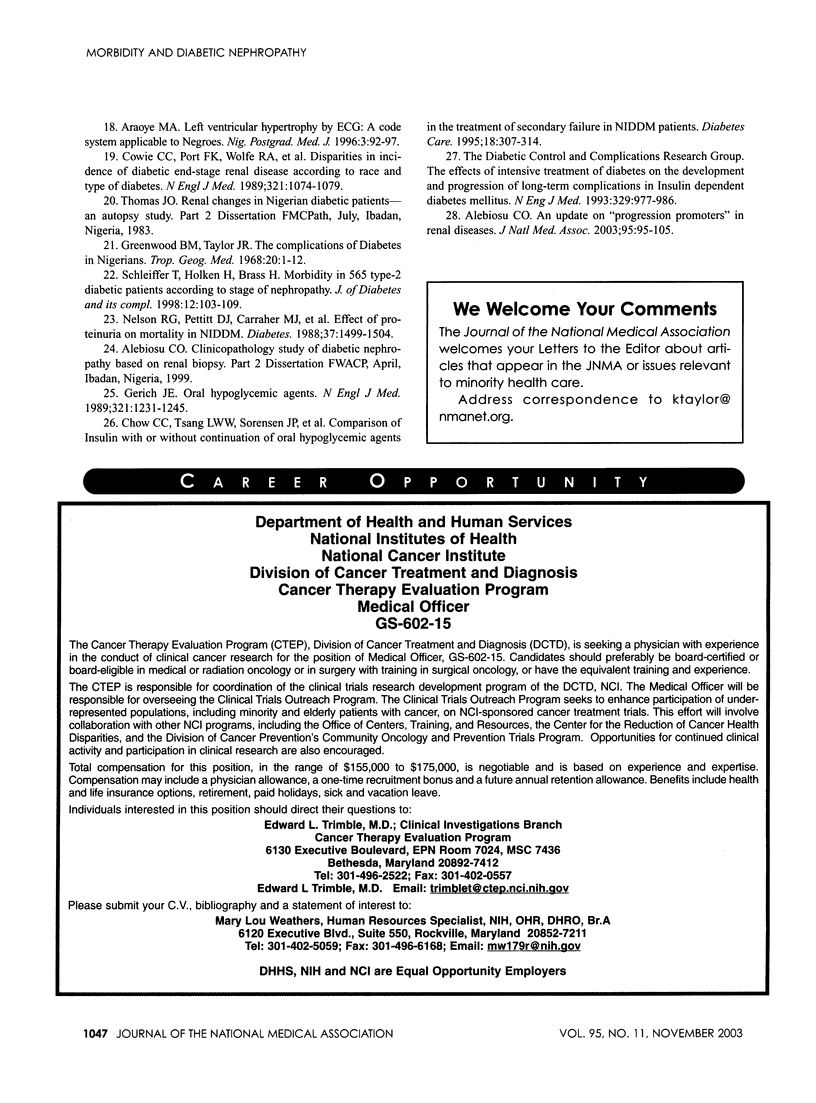
Selected References
These references are in PubMed. This may not be the complete list of references from this article.
- Akinsola W., Odesanmi W. O., Ogunniyi J. O., Ladipo G. O. Diseases causing chronic renal failure in Nigerians--a prospective study of 100 cases. Afr J Med Med Sci. 1989 Jun;18(2):131–137. [PubMed] [Google Scholar]
- Alebiosu C. O. Clinical diabetic nephropathy in a tropical African population. West Afr J Med. 2003 Jun;22(2):152–155. doi: 10.4314/wajm.v22i2.27938. [DOI] [PubMed] [Google Scholar]
- Alebiosu C. O., Ogunledun A., Ogunleye D. S. A report of clinical trial conducted on Toto ointment and soap products. J Natl Med Assoc. 2003 Jan;95(1):95–105. [PMC free article] [PubMed] [Google Scholar]
- Bojestig M., Arnqvist H. J., Hermansson G., Karlberg B. E., Ludvigsson J. Declining incidence of nephropathy in insulin-dependent diabetes mellitus. N Engl J Med. 1994 Jan 6;330(1):15–18. doi: 10.1056/NEJM199401063300103. [DOI] [PubMed] [Google Scholar]
- Chow C. C., Tsang L. W., Sorensen J. P., Cockram C. S. Comparison of insulin with or without continuation of oral hypoglycemic agents in the treatment of secondary failure in NIDDM patients. Diabetes Care. 1995 Mar;18(3):307–314. doi: 10.2337/diacare.18.3.307. [DOI] [PubMed] [Google Scholar]
- Cowie C. C., Port F. K., Wolfe R. A., Savage P. J., Moll P. P., Hawthorne V. M. Disparities in incidence of diabetic end-stage renal disease according to race and type of diabetes. N Engl J Med. 1989 Oct 19;321(16):1074–1079. doi: 10.1056/NEJM198910193211603. [DOI] [PubMed] [Google Scholar]
- Gerich J. E. Oral hypoglycemic agents. N Engl J Med. 1989 Nov 2;321(18):1231–1245. doi: 10.1056/NEJM198911023211805. [DOI] [PubMed] [Google Scholar]
- Greenwood B. M., Taylor J. R. The complications of diabetes in Nigerians. Trop Geogr Med. 1968 Mar;20(1):1–12. [PubMed] [Google Scholar]
- Mogensen C. E., Christensen C. K., Vittinghus E. The stages in diabetic renal disease. With emphasis on the stage of incipient diabetic nephropathy. Diabetes. 1983 May;32 (Suppl 2):64–78. doi: 10.2337/diab.32.2.s64. [DOI] [PubMed] [Google Scholar]
- Nelson R. G., Pettitt D. J., Carraher M. J., Baird H. R., Knowler W. C. Effect of proteinuria on mortality in NIDDM. Diabetes. 1988 Nov;37(11):1499–1504. doi: 10.2337/diab.37.11.1499. [DOI] [PubMed] [Google Scholar]
- Osuntokun B. O., Akinkugbe F. M., Francis T. I., Reddy S., Osuntokun O., Taylor G. O. Diabetes mellitus in Nigerians: a study of 832 patients. West Afr Med J Niger Pract. 1971 Oct;20(5):295–312. [PubMed] [Google Scholar]
- Ritz E., Orth S. R. Nephropathy in patients with type 2 diabetes mellitus. N Engl J Med. 1999 Oct 7;341(15):1127–1133. doi: 10.1056/NEJM199910073411506. [DOI] [PubMed] [Google Scholar]
- Ruggenenti P., Remuzzi G. The diagnosis of renal involvement in non-insulin-dependent diabetes mellitus. Curr Opin Nephrol Hypertens. 1997 Mar;6(2):141–145. doi: 10.1097/00041552-199703000-00006. [DOI] [PubMed] [Google Scholar]
- Schleiffer T., Hölken H., Brass H. Morbidity in 565 type 2 diabetic patients according to stage of nephropathy. J Diabetes Complications. 1998 Mar-Apr;12(2):103–109. doi: 10.1016/s1056-8727(97)00003-2. [DOI] [PubMed] [Google Scholar]
- Sowers J. R., Epstein M. Diabetes mellitus and associated hypertension, vascular disease, and nephropathy. An update. Hypertension. 1995 Dec;26(6 Pt 1):869–879. doi: 10.1161/01.hyp.26.6.869. [DOI] [PubMed] [Google Scholar]


